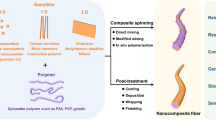Abstract
This paper investigated the characteristics of fiber bundles which are used for fibrous composite materials. Unembedded or dry fiber bundles were tested under monotonically increasing tensile loading. A statistical model was developed based on the slack fibers to explain the test results of the unembedded fiber bundles. Then, the behavior of the unembedded fiber bundles was compared to the fiber bundles embedded in composite materials, i.e., fiber bundles present in a matrix material. Next, unembedded fibers under tensile cyclic loadings with the displacement control mode were examined. The cyclic test results were also predicted using the statistical slack model. Finally, the residual strength and stiffness of fiber bundles were determined after undergoing different numbers of cyclic loads. Tensile tests were conducted for the same fiber bundles until failure after they were subjected to the specified cyclic loading. These tests provided data for the reduction in strength and stiffness of the fiber bundles resulting from the cyclic loading. These results would then be used in generating a cyclic fatigue failure model based on the multiscale approach that uses the cyclic test data of fibers and matrix materials instead of those of composite specimens.




















Similar content being viewed by others
References
Adam T, Diekson RF, Jones CJ, Reiter H, Harris B (1986) “A power law fatigue damage model for fiber-reinforced plastic laminates. Proc Inst Mech Eng 200(C3):155–166
Bhattacharyya P, Pradhan S, Chakrabarti BK (2003) Phase transition in fiber bundle models with recursive dynamics. Phys Rev E 67:046122
Coleman BD (1956) “Time dependence of mechanical breakdown phenomena. J Appl Phys 27(8):862–866
Coleman BD (1957) “Time dependence of mechanical breakdown in bundles of fibers. II. The infinite ideal bundle under linearly increasing loads. J Appl Phys 28(9):1065–1067
Coleman BD (1958) “statistics and time dependence of mechanical breakdown in fibers. J Appl Phys 29(8):968–983
Daniels HE (1945) The statistical theory of the strength of bundles of threads. I Proc R Soc A 183(995):405–435
Kwon YW, Darcy J (2018) Further discussion on newly developed failure criteria for fibrous composites. Multiscale Multidiscip Model Exp Design 1(4):307–316
Kwon YW, Darcy J (2018A) Failure criteria for fibrous composites based on multiscale modeling. Multiscale Multidiscip Model Exp Des 1(1):3–17
Kwon YW, Panick CJ (2020) Strain rate dependent failure criteria for fibrous composites using multiscale approach. Multiscale Multidiscip Model Exp Des 3(1):11–22
Kwon YW, Park MS (2013) Versatile micromechanics model for multiscale analysis of composite structures. Appl Compos Mater 20(4):673–692
Mallick PK (2011) Chapter 13: Testing the fatigue strength of fibers used in fiber-reinforced composites using fiber bundle tests. In: Guedes M (ed) Creep and fatigue in polymer matrix composites. Woodhead Publishing, Sawston, pp 409–423
Nakai-Chapman J, Park YH, Sakai J (2021) Implementation of progressive failure for fatigue based on cycle-dependent material property degradation model. Multiscale Multidiscip Model Exp Design 4(1):41–50
Park MS, Kwon YW (2013) Elastoplastic micromechanics model for multiscale analysis of metal matrix composite structures. Comput Struct 123:28–38
Peirce FT (1926) Tensile tests for cotton yarns “the weakest link” theorems on the strength of long and of composite specimens. J Text Inst Trans 17(7):T355–T368. https://doi.org/10.1080/19447027.1926.10599953
Phoenix SL (1978) Stochastic strength and fatigue of fiber bundles. Int J Fract 14(3):327–344
Pradhan S, Chakrabarti BK (2003) Failure due to fatigue in fiber bundles and solids. Phys Rev E 67:46124
Pusch T (2016) Textile testing methods. In: Cherif C (ed) Textile materials for lightweight constructions. Springer, Berlin, Heidelberg, pp 479–535. https://doi.org/10.1007/978-3-662-46341-3_14
Qian C, Nijssen RPL, Samborsky DD, Kassapoglou C, Gurdal Z. Zhang GQ (2010) Tensile fatigue behavior of single fibers and fiber bundles. In: 14th European Conference on Composite Materials, 7–10 June. Budapest (Paper ID: 484-ECCM14)
Shokrieh MM, Lessard LB (2000) Progressive fatigue damage modeling of composite materials, part I: modeling. J Compos Mater 34(13):1056–1080
Zhou Y, Mallick PK (2004) Fatigue strength characterization of E-glass fibers using fiber bundle test. J Compos Mater 38(22):2025–2035
Zhou Y, Baseer MA, Mahfuz H, Jeelani S (2006) Statistical analysis on the fatigue strength distribution of T700 carbon fiber. Compos Sci Technol 66:2100–2106
Acknowledgements
This work was sponsored by Office of Naval Research, Aerospace and Structure Program. The support is greatly appreciated. The authors also appreciate the support of Mr. John Mobley for his assistant with preparing the test apparatus.
Author information
Authors and Affiliations
Corresponding author
Ethics declarations
Conflict of interest
The authors do not have any conflict of interest associated with this research.
Data availability statement
All the data are provided in the paper.
Additional information
Publisher's Note
Springer Nature remains neutral with regard to jurisdictional claims in published maps and institutional affiliations.
Rights and permissions
About this article
Cite this article
Kadlec, L., Kwon, Y.W., Haller, C. et al. Tensile and cyclic loading of fiber bundles. Multiscale and Multidiscip. Model. Exp. and Des. 4, 245–257 (2021). https://doi.org/10.1007/s41939-021-00098-2
Received:
Accepted:
Published:
Issue Date:
DOI: https://doi.org/10.1007/s41939-021-00098-2




